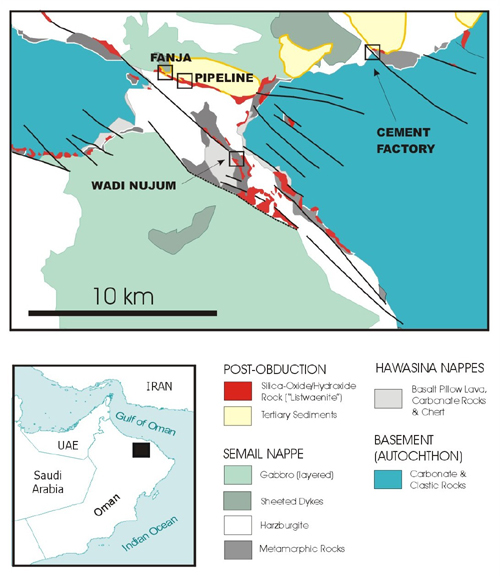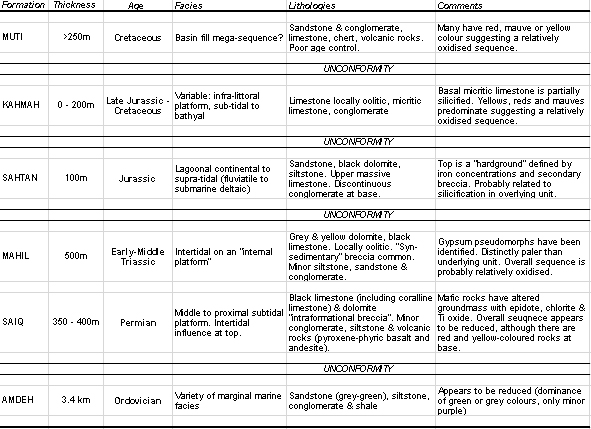Preliminary
study of Cenozoic hydrothermal alteration and platinum deposition in the
Oman Ophiolite
Introduction
The Semail ophiolite of Oman is perhaps the most intensely studied ophiolite in the world and the presence of unusual silica, iron oxide/hydroxide and carbonate hydrothermal alteration within it has long been known (Glennie et al., 1974; Stanger, 1985; Villey et al., 1986). There has been only one substantial study of this alteration (Stanger, 1985) despite the fact that in other ophiolite bodies (e.g. Morocco, Saudi Arabia) similar alteration is associated with potentially economic gold concentrations (Buisson & LeBlanc, 1985 & 1987). In this paper, we present new field observations, new mineralogical and geochemical data and geochemical models of water-serpentinite interaction. We present a preliminary hypothesis for the formation of this hydrothermal alteration and sub-economic platinum mineralization, involving high heat flow associated with post-obduction Tertiary faulting and magmatism and circulation of oxidised groundwaters similar to those present today. Relatively Pt and Pd depleted chromite pods are proposed as a possible source of these elements.
Glennie et al. (1974) first mapped the silicified (“listwaenite”) portion of the Semail ophiolite of Oman, as the Amqat lithostratigraphic unit. Stanger (1985) noted that the Amqat unit is within the basal serpentinite, sometimes being part of a basal thrust. He inferred that silicification was spatially and temporally associated with Palaeogene fault movement. Stangers’ work also suggested that the silica and iron oxides replaced serpentinised ultramafic as evidenced by the presence of (presumably residual) chromite and similar amounts of Al, Fe and Cr in serpentinite and silicified serpentinite.
Elsewhere, hydrothermally altered ophiolite (listwaenite) of Saudi Arabia, hosts ancient gold workings at the margin of serpentinised ultramafic rock masses. Hydrothermal alteration phases include talc, dolomite, magnesite, magnesian chlorite and fuchsite, while chromite is a relict, metastable phase inherited from the precursor rock (Buisson & LeBlanc, 1987). Economic gold (> 1 ppm) occurs in pyrite- and gersdorffite-rich zones and in late quartz veins, and has been observed at the margins of pyrite crystals (Buisson & LeBlanc, 1987).
Another example of precious metal associated with altered ophiolite is the Bou Azzer ophiolite in Morocco (Buisson & LeBlanc, 1985 & 1987). Small cobalt orebodies (now mined out) consisted of arsenide minerals (e.g. skutterudite) in a calcite-dolomite gangue with hematite, magnetite and quartz. About 5 tonnes of by-product gold was recovered. Elevated gold (1 – 10 ppm) occurred in rocks containing high levels of pyrite and cobalt arsenide or late pyrite and arsenopyrite-bearing quartz veins (Buisson & LeBlanc, 1985 & 1987). Gold-rich rocks also contain high levels of Sb, Bi and Ag. The contact between ore and serpentinite was marked by a distinct talc-serpentine-carbonate zone (listwaenite) and Mg-chlorite and serpentine become more abundant with proximity to unaltered serpentinite, suggesting hydrothermal zonation.
Buisson & LeBlanc (1987) have argued that the gold was deposited from modified CO2-rich seawater that circulated through the ophiolite during serpentinisation. They cite fluid inclusion evidence for temperatures of 150 to 250°C. Gold was inferred to have been introduced as a sulphide or arsenide complex and precipitated due to pH change and/or change in oxidation state that resulted from interaction of hydrothermal fluid and carbonate rocks. Gold is inferred to have been derived from magnetite contained within the serpentinite.
This model contrasts with Stanger’s (1985) proposed mechanism for the formation of the Amqat “listwaenite” and associated carbonate-rich rocks. He proposed an early serpentinization driven by seawater ingress into the ophiolite. The seawater was regarded as a source of arsenic. Formation of the Amqat “listwaenite” was however ascribed to circulation of slightly acidic and CO2-rich groundwater at less than 50°C.
Hopkinson (2001) provided an unusual explanation for the “listewaenite” involving salt diapirism through the ophiolite. The evidence for diapirism is, however, limited to the presence of rare salt-rich rocks in a fault zone at Qantab. A plausible alternative explanation is that the salt is derived from localized evaporation of contemporary groundwaters.
Four Main Tectonostratigraphic Units
The geology of the study area is shown as figure 1, which is based on the mapping of Villey et al. (1986), as is the account of the regional geology given below. Four major tectono-stratigraphic units can be differentiated. The oldest rocks in the area, referred to herein as basement, are autochthonous Ordovician to Cretaceous carbonate and clastic sedimentary rocks, summarized in Table 1. Overall the rocks are red, yellow or mauve in colour. Pseudomorphs after gypsum have been noted, but appear to be uncommon. The Saiq Formation is conspicuously darker, and yields H2S when struck with a hammer. Basaltic and andesitic volcanic rocks form a small part of the overall basement sequence. Pyroxene phenocrysts are preserved but the ground mass is commonly altered to an assemblage of epidote, chlorite and Ti-oxide of uncertain age.
 |
| Figure 1. Geology of the Fanjah area, showing the distribution of “listwaenite” simplified after Villey et al. (1986). Quaternary deposits related mainly to wadis are not shown. |
 |
| Table 1: Stratigraphy and lithologies of the pre-obduction autochthonous basement (compiled from descriptions in Villey et al., 1986). |
Overlying
the basement rocks are autochthonous rocks of the Permian Al Jil Formation,
part of the Hawasina Nappes. These include alkalic basaltic to andesitic
lavas, shale, conglomerate, limestone radiolarian chert and sandstone.
Primary magmatic minerals include plagioclase, clinopyroxene and various
opaque minerals. Magmatic plagioclase has been replaced by albite and
carbonate and chlorite are common secondary phases. The chemical composition
of the lavas suggests formation in a rift environment (Cotton et al.,
2001).
The next major tectono-stratigraphic unit is the Semail nappe consisting
of ophiolitic harzburgite, separated by a discontinuous dunite layer
from overlying layered gabbro and a sheeted dyke unit of dolerite dykes
with chilled margins. These rocks were tectonically emplaced over the
basement during obduction in the Cretaceous (e.g. Hanna, 1992). Superimposition
of the ophiolite sequence on underlying sediments created quartzite,
garnetiferous muscovite schist, chlorite schist and amphibolite collectively
known as the metamorphic sole.
About 90% of the “mantle” sequence has undergone serpentinisation of intensity varying between 55 and 85% by volume (Stanger, 1985). Veins of carbonate (mainly magnesite) are almost ubiquitous (Stanger, 1984). A range of Ni minerals has been described including acicular niccolite, annabergite, maucherite, Ni-nontronite and Ni-montmorillonite (Haynes, 2001; Stanger, 1985; Hopkinson, 2002). Another alteration type is rodingite, found in faults and joints, consisting of hydrogrossular, prehnite and zoisite.
Overlying gabbro also displays evidence for post-intrusion hydrothermal alteration, namely the presence of tremolite-actinolite, epidote, chlorite, sphene, prehnite, talc and magnetite and locally sulphide minerals (e.g. Nehlig & Juteau, 1988). The age (or ages) of this widespread and locally intense alteration, however, remains uncertain.
Post-obduction cover rocks vary in age from Late Cretaceous to Quaternary and consist of conglomerate, limestone and sandstone unconformably overlying all older units. They were deposited in environments that range from marginal marine to inner shelf (e.g. Racey, 1994). The Tertiary rocks are unmetamorphosed, but in the vicinity of the cement factory (Fig. 1) show varying degrees of silicification, and iron metasomatism and up to 100 ppb gold has been recorded (Haynes, 2001). Locally, harzburgite faulted against the Tertiary rocks has been altered to an assemblage of Ni-montmorillonite and halloysite (Haynes, 2001).